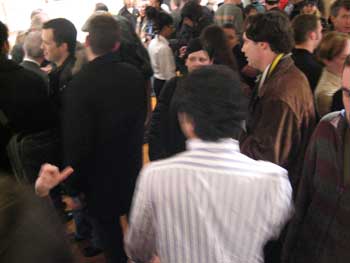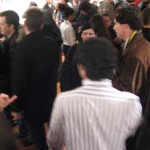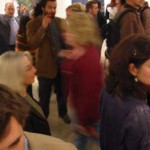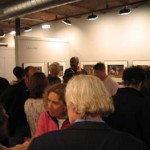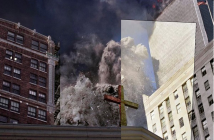In our efforts to understand and accurately represent the full scope of our art scene, Big RED & Shiny sent a survey to the commercial galleries of New England. About half of those contacted replied, and the results give an interesting glimpse into the generally opaque world behind the scenes of the galleries many artists stake their careers on. While not 100% thorough [1], the results give us an opportunity to discuss several aspects of our commercial culture, and to build on the successes while considering some improvements.
To paraphrase the president [2]: "The State of the Arts in Boston is Strong!" Below is a breakdown of our survey results, along with thoughts and analysis.
The Basics
The first two unsurprising facts about our commercial galleries are that many of them have been uprooted and that most of them are now in the South End/SoWa district. Nearly 2/3 of our respondants were from that area, although suburban-Boston made a strong showing, with Brookline, Lawrence, Somerville and Salem all checking in. Of course, so did Newbury Street.
On average, galleries have been open about 6 years, but only in their current location 3.5 years. Considering the major uprooting of many galleries into the SoWa complex a few years back, this is not surprising. When Judi Rotenberg Gallery's 20+ years are factored in, the average time most galleries have spent in their current location drops to 2.2 years. The high rents of desireable areas, and the recent rise in commercial gallery activity, account for much of this short-term occupancy. Weighed against 5 respondants whose galleries have existed for 7 years or longer, while only 2 have been in their current location for that time, and we see clear evidence of the real estate explosion of the past 5 years.
When looking at the make-up of the galleries, the number of staff also factors into their impact and presence. Of 13 respondants, only 3 reported a paid staff larger than a single employee (for an average of 1.5 employees per gallery). The impact of this is clear, as it means that a single face and curatorial voice represent the gallery to the public. It means a clear vision on the gallery walls, but also a potential for small circles of artists to gain influence in sectors of the scene.
Overall, there are not really any surprises in the general make-up of the scene. Recent explosions in real estate, coupled with the rise of SoWa, have consolidated much of the commercial galleries in urban Boston to two neighborhoods, while outer areas and suburbs may support one or two galleries at best. A quick look at the Big RED venues section confirms this conclusion, and makes it clear that while alternative spaces and academic galleries can draw audiences to a wide range of neighborhoods and suburbs, sales are isolated to few tightly packed districts on Newbury Street and in SoWa. It remains to be seen what impact the new ICA building on the waterfront will have as developers scramble to create new gallery-friendly spaces in the area, and whether or not we will see the sort of exodus that took place a few years ago among Newbury Street galleries as SoWa grew.
Exhibitions
Of the resonding galleries, 2/3 present new shows every month. The bulk of the remainder turn over every two months. This means that a vast array of artwork is available to art lovers every month, and annually audiences can consume art by the bucket-full. SoWa's First Fridays most likely represents much of these shows, and the benefits of frequent turnover and the audiences drawn by the event have certainly been weighed by SoWa galleries and found beneficial. Coupled with the need to make sales and bring in collectors who desire works, a month seems ample time to achieve those goals. It does beg the question, however: why not bi-weekly? Is there something specific about a month that gives a gallery the needed time to move the work, or is it merely a convention that is followed out of convenience? I imagine, given the overwhelming numbers of galleries who work in month-length increments, that the time has proven to be just right, but cannot help but ponder the pros and cons of a scene that turns over bi-weekly.
Looking at the types of work being shown, paintings, drawings, mixed media wall work, photographs and sculptural work of various media all scored high. 8 of our respondants said they show video work (although who is actually selling video work is another question...) and few are interested in performance art or sound work. A little less than half are willing to work with independent curators, although the frequency and scope of those shows is a topic that could fill a whole article.
Sales
Being a commercial gallery is about making money through the sale of art. Many things factor into the sale of an artwork, including it's aesthetic value, relationship to current trends, engagement with contemporary discourse, hype value, and other intangibles. While none of our questions addressed any of these subjects, we were able to look at who was buying the work and when.
First, Boston galleries are quite kind to their artists. The average percentage of sales taken by galleries was 37.5%, with no galleries reporting more than 50%. While not measured by our survey, one assumes that location, longevity, and collector base contribute to how much an artist can expect to surrender to their gallery.
Of the responding galleries, an average of 41.4% of their sales were to collectors they work with regularly, and who seek out their gallery for work. Amazingly, this startlingly average number is the result of two extreme responses. 6 galleries reported less than 20% of sales to collectors (3 reported 0%) while 4 claimed 80-90% sales exclusively to regular collectors.
The exciting numbers, though, concern the amount of sales to walk-in buyers or occasional collectors. Averaging 45.7%, the stats are skewed by 4 respondants reporting 80-100% sales to this audience. While the collector sales above can be attributed to longevity and experience, this amount of transaction with an unpredictable market shows that New England has a broad appetite for art, and that sales to people not yet confirmed as serious collectors can support a number of commercial venues. More importantly, it signals a growing audience who may soon become serious collectors that engage with art and artists on many levels. This is a very positive sign, worthy of consideration as it points to the future of the art market in Boston.
Demographics
Being older in Boston does have it's advantages. Specifically, being 30-50 in the arts scene, one can expect a lot. The average age of artists represented by reporting galleries was about 33, while the average age of art buyers was about 44. Younger artists need not cry, as 4 galleries reported the average age of their artists as 30 or under. No galleries claimed the average age of their collectors in that range, though, with the bulk (90%) falling between 36-50. Given the number of colleges in the region, the youth of our artists need not be a surprise, although the (relative) youth of the collector market may be. Like the strong numbers for occasional buyers above, this points to a lot of potential growth in the collector base, and the opportunity to develop long-term relationships with collectors that will support the community for extended amounts of time.
For those of us who have been arguing against Boston as a provincial backwater, the demographic numbers take an awkward turn. 62% of represented artists are local, while 73% of collectors are from the region. While this is sign that our scene is strong and can support itself, it also points to an isolation from the larger artworld. Some of this could be accounted for by the vast exodus of artists to New York every year, yet the fact that most collectors are regional undermines many hopes that Boston will become the international city it could be as it caters to regional supporters whose (well-deserved) opinions clash with larger, international trends.
Visibility
The last category of information about our commercial galleries concerns how their audience finds them. It is true that newer galleries must work harder to find an audience, and that established venues can work more securely with their collectors and recognition, but all commercial enterprises must strive to reach a broader audience.
Only about 1/3 of galleries attend art fairs, which seems about right. As there are no major art fairs in Boston, and 73% of collectors are local, the logic of staying home is clear. However, if larger markets could open our region to more international collectors, it might be worth discussing the role of the art fair in contemporary sales.
When it comes to advertising, on both a local and national/international scale, 42% of galleries report buying ads in art magazines in their search for a broader audience. A larger number (57%) count on the direct contact between artist and audience that occurs at gallery talks to connect with buyers.
To be fair, the visibility of our galleries might be better gauged by the attendance of openings and receptions, most notably the First Friday openings. In a market dominated by young artists fresh out of (or current enrolled in) college, the impact of such visibility may be hard to measure. Surely the intangibles of hype and attention help to sell work, but isolating the effects of First Friday masses on the sale of art would be difficult (if not impossible).
Conclusions
In areas where Boston would be expected to be strong, it is. Galleries represent a wide range of local artists, and their work is collected by an overwhelmingly local audience. Commerce is largely restricted to a handful of pockets, while outer neighborhoods and suburbs support one or two galleries. The recent upheaval in real estate values has caused many to relocate, but it has also encouraged many more galleries to start up, and to show a varied range of work. Independent curators have a reasonable outlet for their voice in the commercial scene, and sales to non-collectors support a significant percentage of spaces.
Overall, whether it is surprising or not, our commercial galleries are doing exactly what we want them to. Experimental work barely registers in the survey results, but with strong academic galleries and an indie scene that is harder to kill than a movie zombie, they can sit back and consider what is worth presenting their audience without fear that such works will not have a voice. A proximity to New York brings their artists here as it sends our artists there, and the crossover of curators, collectors and ideas keep things from getting stale.
Are there areas for improvement? Certainly. We could close the gaps between experimental and commercial spaces, and find ways of creating audiences for risky work. We could open more potential forums that expand the visibility of our scene [3] in order to help artists and galleries alike. There are many things to consider, some of which are already being tackled in various ways by galleries, artists, curators, indie spaces, and bloggers. For others, time can only tell.
The state of the arts in Boston is strong. The next year is a big one, and we have our fingers crossed.
----
[1] - Of the 35 galleries contacted, 16 responded. All questions were optional, so some answers reflect less than total responses.
[2] - To call him 'our President' would imply that we voted for him, support him, or that his policies represent us. He is 'the president' as none of these apply.
[3] - Big RED's annual budget for our first year was $60.
----

